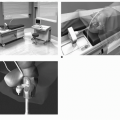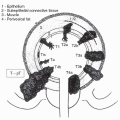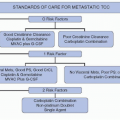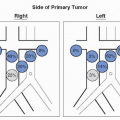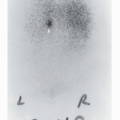Management of Nongerm Cell Testis
Jeffrey M. Holzbeierlein
Michael E. Karellas
INTRODUCTION
Although testicular cancer is a rare malignancy overall, it is the most common solid tumor in men aged 18 to 35. Furthermore, testicular cancer is one of the true success stories in medicine with an overall cure rate of around 98%. The vast majority of neoplasms are germ cell tumors, and the treatment of these is well established. Non-germ cell tumors are known as sex cord-stromal tumors (SCST), and although SCST comprise only 4% of testicular neoplasms, the understanding of the biology, behavior, diagnosis, and treatment remains important. The SCST neoplasms include Leydig (interstitial) cell tumors, Sertoli cell tumors (SCT), and Granulosa cell tumors. These tumors may be pure cell types or may comprise a combination of these cell types with variable degrees of differentiation. The classification of these tumors has been described by the World Health Organization (Table 36.1).
LEYDIG (INTERSTITIAL) CELL TUMOR
The Leydig cells (LC) are interstitial cells located between the seminiferous tubules, primarily responsible for the production of testosterone in response to stimulation by luteinizing hormone (LH).
The development of the LC is intimately related to testosterone surges that occur during the life of human males (1). LC differentiation begins from the mesoderm at the eighth week of gestation and these cells comprise approximately half the testicular volume when testosterone activity peaks at the 15th week of gestation. Testosterone produced at this time results in the differentiation of the epididymis, vas deferens, and seminal vesicles. In addition, the conversion of testosterone from the LC results in dihydrotesterone-mediated masculinization of genitalia and differentiation of the prostate gland. At approximately 2 months after birth, there is an increase in LH that results in the second testosterone peak. This results in the male imprinting of androgen-dependent tissues (2). A final peak of testosterone produced by the LC occurs at puberty resulting in virilization and the onset of spermatogenesis. LC volume undergoes a 50% reduction during the first 30 years of life. Senescence is accompanied by decreasing levels of testosterone due to declining LC volume despite normal or increased LH levels (3).
TABLE 36.1 CLASSIFICATION OF NONGERM CELL TUMORS OF THE TESTIS | |||||||||||||||||||||||||||||||||||||||||||||||||||
|---|---|---|---|---|---|---|---|---|---|---|---|---|---|---|---|---|---|---|---|---|---|---|---|---|---|---|---|---|---|---|---|---|---|---|---|---|---|---|---|---|---|---|---|---|---|---|---|---|---|---|---|
| |||||||||||||||||||||||||||||||||||||||||||||||||||
The hypothalamus-pituitary axis regulates the LC function and testosterone production. Gonadotropic releasing hormone (GnRH) synthesized in the hypothalamus stimulates release of follicle stimulating hormone (FSH) and LH from the anterior pituitary gland. LH binds to LCs and stimulates production of testosterone. Testosterone regulates feedback on GnRH pulses and resultant LH and FSH secretion.
Leydig Cell Tumorigenesis
Tumors of the LC are rare and comprise only 1% to 3% of testicular neoplasms. However, they are the most common interstitial neoplasm of the testis and account for 40% of all non-germ cell testicular tumors (3). Most of our knowledge of LC tumorigenesis comes from animal models or in vitro human cells. It is generally believed that the development of Leydig cell tumors (LCT) is influenced by both gonadotropin and nongonadotropin components.
One theorized risk factor for the development of LCT results from the prolonged exposure to exogenous estrogens. The formation of LCT was demonstrated in mice that received prolonged estrogen administration (4). Increased circulatory levels of LH/human chorionic gonadotropin (hCG) or GnRH have also been shown to have the potential to cause LC hyperplasia (LCH) in vitro (5). In in vitro studies, increased levels of LH/hCG produced a transient elevation of protooncogenes resulting in immediate early gene expression demonstrating LH-induced mitogenesis (6,7). Finally, exposure to antiandrogens such as flutamide that block the hypothalamic-pituitary feedback of testosterone causing hypersecretion of LH has resulted in LCH and tumors in rats, although there are no reported cases of this in humans (8). Another cause of LCT appears to be an association with neonatal hypothyroidism that results in an increased LC population in adulthood (9). This increased number of LC occurs in the presence of low LH and FSH, and has been correlated with an increased incidence of LCT. It is believed that this sustained reduction in responsiveness of LC to LH may play a role in LC tumorigenesis. Other nongonadotropin factors that may contribute to LC tumorigenesis include factors influencing seminiferous tubule damage, Sertoli cell-mediated DNA synthesis that promotes immature LC proliferation, and progesterone secretion (10).
The role of estrogens in the development of LCT is still being investigated. Estrogens stimulate an autocrine mechanism
determining LCT proliferation. The regulation of aromatase by the farsenoid X receptor (FXR) and cyclooxygenase-2 (COX2) affects tumorigenesis of LCTs. The FXR is a member of the nuclear receptor superfamily that regulates bile acid homeostasis. It is a negative modulator of the androgen-estrogen-converting aromatase enzyme in human breast cancer cells. In LCTs, the FXR downregulates aromatase expression in terms of mRNA, protein levels, and enzymatic activity (11). LCT show overexpression of COX2 and active insulin-like growth factor I. This results in increased aromatase transcription and the expression of genes in the cell cycle that sustain Leydig tumor cell proliferation (12).
determining LCT proliferation. The regulation of aromatase by the farsenoid X receptor (FXR) and cyclooxygenase-2 (COX2) affects tumorigenesis of LCTs. The FXR is a member of the nuclear receptor superfamily that regulates bile acid homeostasis. It is a negative modulator of the androgen-estrogen-converting aromatase enzyme in human breast cancer cells. In LCTs, the FXR downregulates aromatase expression in terms of mRNA, protein levels, and enzymatic activity (11). LCT show overexpression of COX2 and active insulin-like growth factor I. This results in increased aromatase transcription and the expression of genes in the cell cycle that sustain Leydig tumor cell proliferation (12).
Other than the mechanisms described above, there are no proven risk factors for the development of LCT. One previous report demonstrated an increased risk in patients with a history of an undescended testicle (13). Rare examples have been reported with Klinefelter syndrome that may be related to increased levels of gonadotropins. Extratesticular LCTs have also been reported in the spermatic cord, adrenal gland, and the ovaries (14).
Clinical Presentation of Leydig Cell Tumor
Testicular LCTs can occur at any age; however, they most commonly occur in prepubertal boys aged 5 to 10 years and in men aged 30 to 60 years (15). LCTs appear to behave in a benign fashion in prepubertal males, but in adults, they can be malignant in up to 10% of cases. Typically, LCTs are hormonally active steroid-secreting tumors, usually producing testosterone, although, estrogen can also be produced either by direct production of estradiol or by peripheral aromatization. In boys who present with precocious puberty, LCT, Leydig cell hyperplasia, and congenital adrenal hyperplasia should all be in the differential diagnosis.
LCTs produce androgens independent of the hypothalamus-pituitary axis with testosterone being the major androgen produced which leads to the early virilization of prepubertal males. Serum gonadotropin levels are usually low to normal. The steroid secretion patterns may be variable and therefore diagnostically challenging. Concentrations of dehydroepiandosterone, androstenedione, and 17-hydroxyprogesterone are usually normal but elevations have been reported. LCTs are autonomous and do not respond to suppression or stimulation tests in contrast to tumors of CAH.
Most children with LCTs present with isosexual precocity, which includes penile enlargement, pubic hair growth, body hair growth, increased stature, increased muscle mass, and advanced bone age. Other secondary sexual characteristics include deepening voice (50%), facial acne (30%), enlarged prostate (20%), gynecomastia (10%), and mood changes as well as emotional problems (1). Such signs or symptoms should raise the suspicion for a testicular tumor and should encourage a careful testicular examination and ultrasound of the scrotum. In postpubertal males, the androgen excess associated with LCT does not typically result in any virilizing signs or symptoms. In this group, painless testicular swelling is the most common presenting symptom followed by bilateral gynecomastia as a result of increased aromatization of androgens or the direct production of estradiol. In such cases it is not uncommon for the gynecomastia to precede the testicular mass. Loss of libido, erectile dysfunction, impotence, and infertility can also be present in adults (16).
Physical examination of the testes usually reveals a nontender, unilateral, intratesticular, palpable mass in more than 90% of cases (13). Bilateral tumors develop in < 3% of patients. This is in contrast to testicular tumors in patients with CAH where 80% of patients present with bilateral tumors. Contralateral enlargement can occur in cases of delayed diagnosis when the elevated testosterone level or residual hCG stimulation masks the unilateral presentation. In fact, a delayed diagnosis of sexual precocity after more than 1 year has been reported in 70% of patients (13).
The suspicion of a Leydig cell tumor should be confirmed by an ultrasound of the testicles which typically reveals a homogenous hypoechoic lesion in the testicle similar to that seen in germ cell tumors. Ultrasound imaging shows hypervascularity of the tumor with prominent peripheral and circumferential blood flow (17). Even in the absence of a palpable tumor, in patients with a high clinical suspicion of LCT (such as precocious puberty or gynecomastia), a testicular ultrasound should be obtained. Tumor markers of germ cell tumors like alpha-fetoprotein, beta-hCG, and placental alkaline phosphatase (PLAP) are usually within normal ranges in pure LCTs.
Gross and Histologic Characteristics
Grossly LCT are usually 3 to 5 cm, well-circumscribed, solid masses confined to testicle. See Figure 36.1. Tumor color depends on the lipid content and may range from brown to yellow to gray-white. The golden brown appearance is due to the lipofuscin pigment of the tumor cells. There are generally five different pathologic findings which are used to define a malignant LCT. These include size >5 cm, invasion of the margins or the lymphovascular space, a high mitotic index, the presence of hemorrhage or necrosis, and replacement of the testis or extension beyond the testicular parenchyma (16).
Histologically, the tumor cells are in nests or sheets separated by delicate fibrovascular septa. Small clusters or trabecula separated by a variable amount of fibrous or myxoid stroma can also be seen (18). Rare cases have been reported with adipocyte differentiation, ossification, and calcification (19). Tumor cells differ from normal LCs in that they have abundant slightly granular eosinophilic cytoplasm, indistinct cell borders, and uniform round or oval nuclei with prominent nucleoli (20). See Figure 36.2. The classical teaching is that Reinke crystals are pathognomonic for LCTs and are present in about a third of the cases (20). The significance of these cylindrical, rectangular, or rhomboid, intranuclear or intracytoplasmic crystals is not known. Immunohistochemical staining with alpha-inhibin, calretinin, and Melan-A can help in establishing the diagnoses of LCT.
Stay updated, free articles. Join our Telegram channel

Full access? Get Clinical Tree


